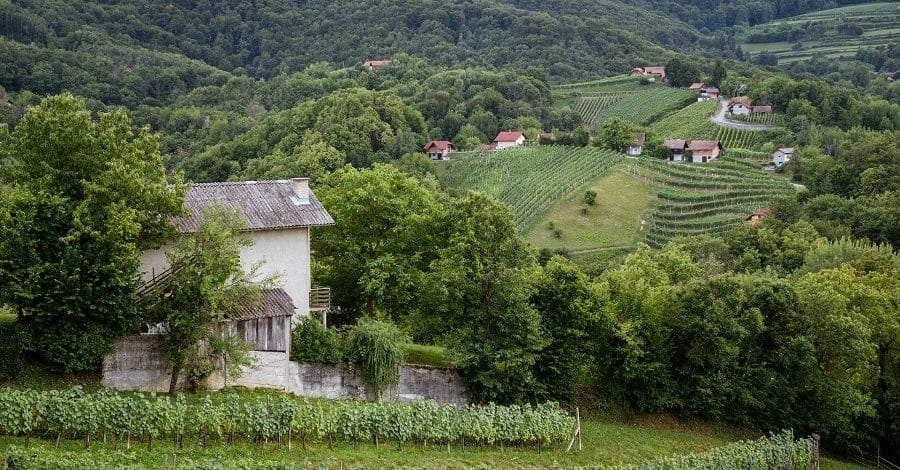Due to its friendly climate, reasonable living costs, diverse geographical terrain, state of the art infrastructure, fairy tale-like forests, and irresistible natural sights, many are moving to Slovenia from US in search of a better life, peace, and a fresh start.
Although this is a tiny country of roughly 2 million people, Slovenia spoils you for choice when it comes to the selection of regions to relocate to. To narrow down your search, we’ll list the top 5 regions that expats tend to gravitate to:
1. Osrednjeslovenska (Central-Slovenia)
Are you the kind of person who can’t live without the nightlife and the hustle and bustle of the big city life? Looking to get a job teaching English as an expat? The central-Slovenian region, with its capital city of Ljubljana, is the place to be – if you don’t mind the relatively higher cost of living, that is.

This cultural hub is a mix of modern and old. In fact, its design was envisioned by Jože Plečnik, a famous Slovenian architect. Not only is the city infused with tradition, you’ll also find plenty of cycling routes and green areas to keep you healthy and in good condition. If nothing charms you more than walking through town, you’ll be pleased to know that the central area of the city is completely closed off to traffic so you’ll free to explore it without having to be on the constant lookout for incoming vehicles.
Living in Ljubljana, make sure to take in the marvelous view from the Ljubljana Castle that is gazing over the city. From there, you’ll be able to see the Triple Bridge and the Dragon Bridge.
Outside of Ljubljana, the central-Slovenian rural area awaits. There, you will be able to find the traditional Slovenian village life with plenty of restaurants, all while having the capital at arm’s length. Compared to living in Ljubljana directly, this should trim down your living costs quite nicely.
2. Štajerska (Styria)
Štajerska is the home of Maribor, Slovenia’s second largest city. Conveniently placed near the Austrian border, many local residents frequently venture over it to find work or for weekend getaways. Inside the city area, you’ll find plenty of traditional architecture ripe with lovely little cafes and bars, making it easy to find a good company.
If you fancy the idea of being near the river, Lent is one of the most stunning places of Maribor for expats and locals alike. This also happens to be the place where Old Vine House is located, housing the world’s oldest grapevine. As of right now, it’s been operational for more than 400 years.

Living in Maribor you’ll find several rental units at much more affordable prices compared to Ljubljana. So for those expats who’d like to experience the Slovenian city life but don’t have the deepest pockets, Maribor is a nice middle ground if you don’t mind sizing down a bit. Since it’s not the largest city around, you can probably walk across it in an hour or less. Despite its size, you’ll be running into a niche store around every corner.
Expats from the US often praise Styria for being a peaceful place and making for a quiet retreat in nature – don’t forget to visit Betnavski gozd and the three lakes if you’re planning on living in Styria. It’s also one of the best place for engaging in sports. During the winter, you can go skiing on Pohorje, and for the rest of the year, it functions as the go-to place for hiking to burn some of those calories!
3. Primorska (Slovenia’s Seaside)
In the Southwest of Slovenia, there is the small but lovely Slovenian coast. Koper is the biggest city in that area and of the oldest cities in Slovenia, often referred to as the city of hundreds of suns. For expats who love the sea, this area is a wonderful choice.
Living in Koper, it’s easy to get lost in the labyrinths of narrow streets, even after you’ve been staying there for a while. However, be prepared to shell out at least 400 EUR a month for a basic apartment – and that’s on the low end of the spectrum. During summer when the tourist season is in full swing, it gets even worse, and the prices get sky-high (Izola and Piran, two smaller Slovenian seaside cities, experience a similar pattern).

If you can somehow get past the accommodation hurdles, you’ll love it here, as most expats report a high quality of life. The food is tasty – seafood in particular is one of its strong points, as expected from a place like this. If you’re after a crazy nightlife, you’ll not find much of it in Koper, but thankfully, Portorož is just 20 minutes away.
The main drawback all expats living in Primorska criticize is the wind. What feels like a welcome breeze during summer, can get almost painfully chilly during the colder months even though the temperatures almost never fall below freezing.
4. Gorenjska (Slovenia’s Alps)
Are you retiring in Slovenia to pursue a more active lifestyle? Gorenjska region, the Slovenian Alps, offers the landscape necessary to reach your hiking and climbing goals. In particular, there are three places of interest you should pay close attention to: Triglav, Stol, and Grintavec, the mountains every expat comes here to conquer.
The closest you’ll find to a city is Kranj, and it’s where you’ll most likely find a place to live as an expat. Living in Kranj is certainly more affordable than the capital city, the latter of which is only about 30 minutes of drive-time away in case you need something.

Kranj is home to stunning architecture. Near the town wall, you’ll see the Khislstein castle that serves as a concert venue and an open-air stage for plays and cultural events. In the Museum of Gorenjska, you’ll learn everything there is to know about Kranj and its stunning 6000 year history. The St. Cantianus Gothic church is a must-see.
Living in Gorenjska, the first thing you’ll notice is its calming natural environment, followed by its diverse and thriving culinary scene. If you don’t mind a slightly cooler climate and if you’re into culture and climbing, consider putting down your roots here.
5. Prekmurje (Northeast)
To the northeast of Slovenia, we have Prekmurje, the most cost-efficient way to live in Slovenia. If you’re the kind of expat who doesn’t mind the overall lack of nightlife and social events and you’re primarily after optimizing your living costs all while connecting with the nature, living in Prekmurje is one of the sanest choices you can make.
To give an example, while a typical restaurant meal will cost you under 10 EUR, in other places in Slovenia, in Prekmurje, you’ll only shell out 5 EUR. The rent here can also be unbelievably affordable, especially if you’re willing to venture out from Murska Sobota and live in the rural areas.

All in all, Prekmurje is all about tradition and living the simple life. In short, this is Slovenia’s farmland hub and as an expat, you’ll get the feeling there is infinite space, thus making it the perfect place to take a walk and explore the nature.
In Murska Sobota, the main city in Prekmurje, you will find plenty of landmarks, including the picturesque Evangelical Church, Rakičan Mansion, Beekeeping Museum Tigeli, Castle Beltinci, and more. Looking for some spa time? Then don’t leave out Moravske Toplice. And don’t forget to taste Prekmurska gibanica, a traditional Slovenian dessert that comes from Prekmurje.
Living in Slovenia, you’ll enjoy a virtually crime-free environment in all the regions, all with decent prices no matter what region you end up choosing. And if you find out it’s not to your liking, there’s nothing stopping you from packing your bags and moving elsewhere – Slovenia is a tiny country, so the trip won’t take long. Since the vast majority of Slovenian people have no problem speaking basic English, you’ll be able to strike up a conversation no matter where you go.

